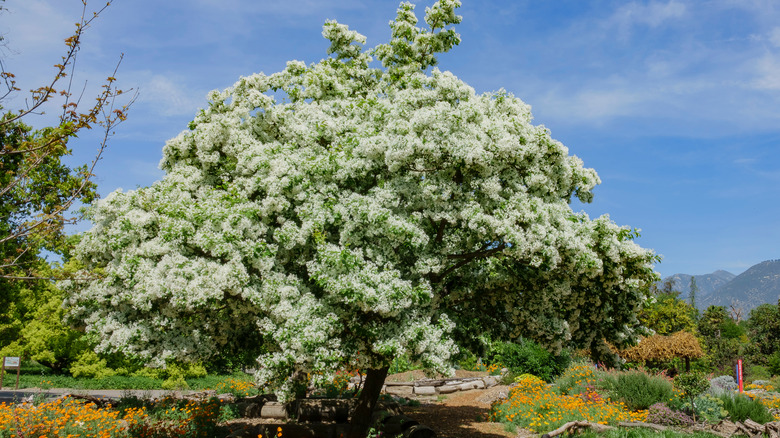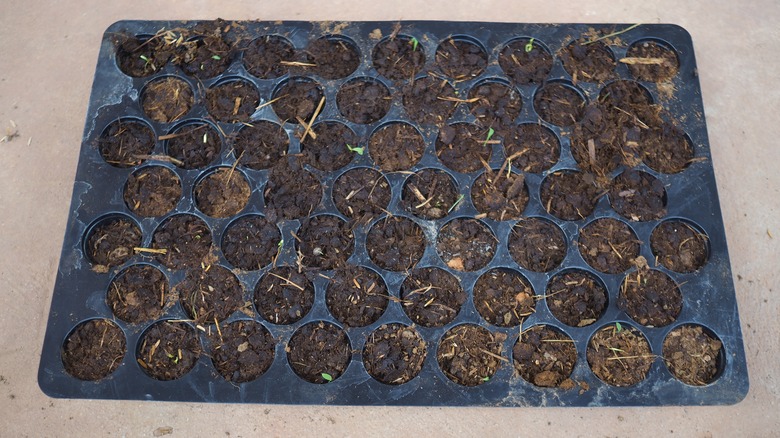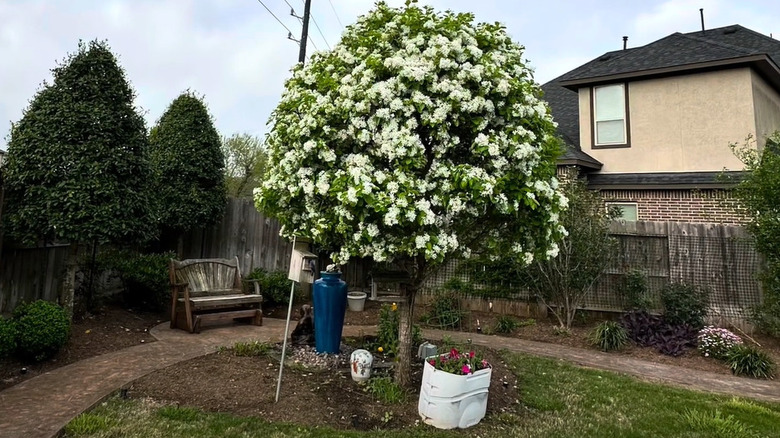Tips For Growing A Healthy White Fringe Tree From Seed
The white fringe tree (Chionanthus virginicus), often lovingly dubbed sweetheart tree or old man's beard is an absolute spotlight-stealer. Picture a round multi-stemmed spring bloomer that shoots up to 12 to 30 feet, adorned with shiny green leaves that shift to bright yellow or yellowish-brown come fall. And the blooms? They're swoon-worthy and sweet-smelling, bursting into a fluffy, white cloud-like display in late spring. Not to mention you attract birds and butterflies with this flowering fall stunner. If thinking of growing a white fringe tree, why not skip the instant gratification of nursery-bought seedlings for the adventure of nurturing your very own from seed? It's a bit of a journey involving seed stratification and nurturing the seedlings in a sunny spot until they are prime to make their debut outdoors.
Fair warning: raising a white fringe tree from seed isn't a quick win. Coaxing these seeds to sprout can take up to two years. And even when they finally pop up, don't expect any growth spurts. This native in USDA zones 3 to 9 grows at a relaxed pace of about 6 to 12 inches per year. However, watching it reach for the skies, bit by bit, is as rewarding as watching your kid grow up. And a little heads-up: The American sweetheart has a doppelganger. The Chinese Fringe Tree (Chionanthus retusus) boasts smaller, tougher leaves. The point is, when shopping for seeds online, make sure the few bucks you drop get you the real deal.
Starting a white fringe tree from seed
First off, fish those seeds out of the pods and strip away the pulp they're hanging onto. Then, soak those seeds in a bowl of warm water for a day. Next up is tricking the seeds into thinking they've just snoozed through winter. This little magic is called stratification. Here's the game plan: Tuck the seeds into a zip-lock bag stuffed with damp sphagnum moss. Now, let those seeds chill in a warm spot at around 68 degrees Fahrenheit for 90 to 150 days. Don't forget to peek in occasionally to ensure the moss stays damp and not waterlogged.
In the meantime, gather up your seed-starting supplies. These include a pot or tray and humus-rich, well-draining potting soil. Following the warm stratification, fill your chosen containers with the seed starting mix, and dibble in small half-inch holes into which you tuck the white fringe seeds. Next, it's time for cold treatment — think 41 degrees Fahrenheit – for another 60 to 90 days.
Following the chilly stint in the fridge, whip that tray of seeds out and find it a spot drenched in sunshine. You could brighten things up with grow lights if sunshine is playing hide-and-seek. If the seedlings are packing on growth, give them more room to stretch in bigger pots. Come fall, when your white fringes shed leaves and their trunks are still skinny (under 2 inches in diameter), move them outdoors in a well-drained spot with slightly acidic soil and plenty of room.
How to care for a white fringe tree
White fringe trees are not super fussy but appreciate a bit of TLC to thrive. These beauties are sun worshippers, so find them a spot that gets at least 6 hours of sunshine daily. And while they won't mind partial shade, don't expect a blockbuster floral show. For those young trees finding their footing, a good soak whenever the top 2 inches of soil feels parched is key to getting their roots stretching and strong. Once they are more established, you can take it easy with your watering duties. But keep a lookout, particularly when the weather starts acting wonky.
White fringes aren't as picky about their food, but if your soil is running empty, a slow-release fertilizer around the tree's base should give it a nudge right before it hits its growth spurt in early spring. Plus, a bit of trimming goes a long way. Snip off the damaged or dead bits after flowering to keep your trees looking sharp and primed for robust growth.
Pests? Borers and scale insects could show up if things get too dry. And diseases? Powdery mildew, canker, and leaf spot are the main culprits. Don't get too trigger-happy with synthetic chemicals — you want to keep the pollinators safe, after all. In fact, neem oil could be your new ally in keeping pests and diseases from harming your trees. Plus, a white fringe tree kept in mint condition is a champ at sidestepping problems.



